How To Count Nodes On A Weed Plant
The 8 Growth Stages of Your Cannabis Plant
Cannabis transitions through several developmental stages, just like we practice.
Cannabis requires different inputs and climate conditions during different growth stages.
This institute volition grow similar a weed when these requirements are met, but success is not guaranteed. Understanding the plant's needs during these eight growth stages volition help you go the best operation from your plants.

Cannabis Developmental Stages:
ane) Seed Storage (Dormancy)
two) Seed Germination Stage
iii) Seedling Stage
iv) Vegetative Growth
v) Sexual Maturity
6) Early-Blossom (Stretch)
7) Mid Flower Stage
8) Late Bloom (Senescence)
1) Seed Storage (Dormancy)
A seed is a storehouse of genetic potential.
When cannabis seeds are properly stored, they tin remain viable for 10-xv years.
The 3 primal conditions for long term storage are Absurd, Dry out, and Nighttime. Seeds are best stored in tinted jars, containing desiccant packs, in the refrigerator.
When you have them out, let the jar come to room temperature before opening to avoid condensation.
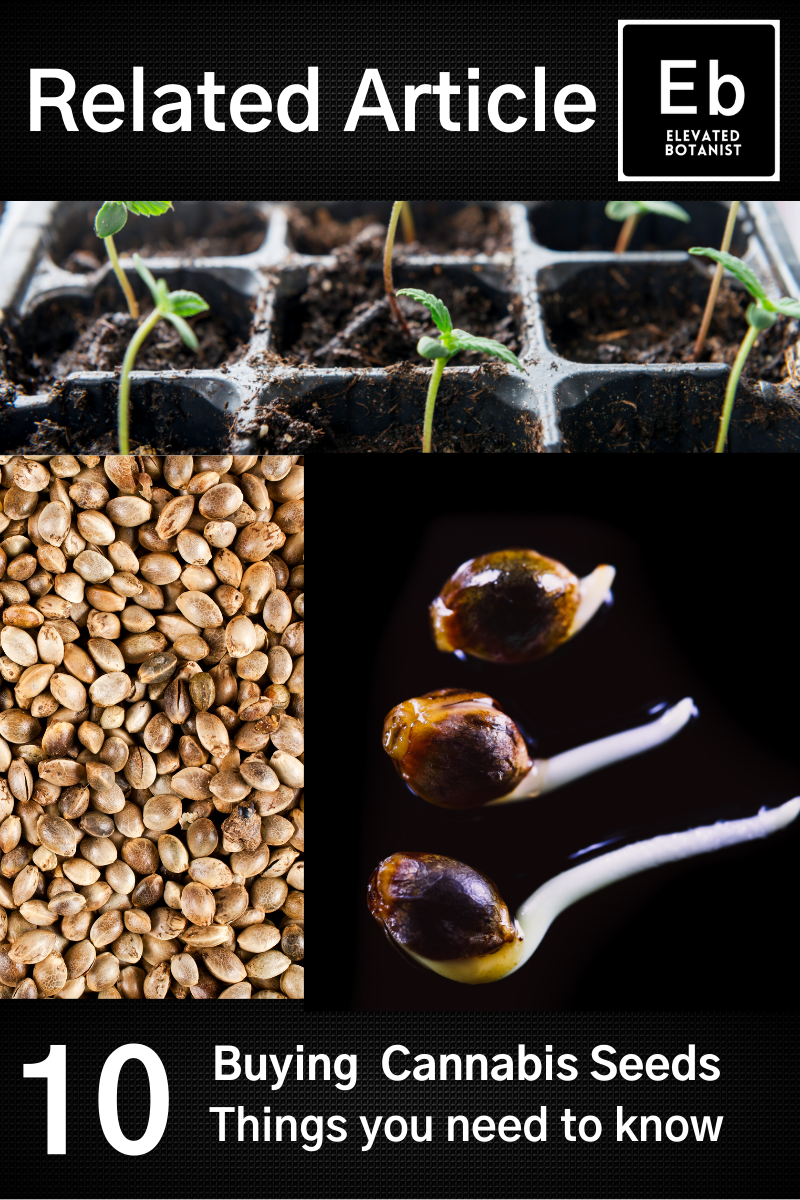
When cannabis seeds are start harvested, they have a high level of dormancy, or resistance to sprouting.
This dormancy is a response to natural seasonal conditions.
If the seeds did non have some level of dormancy, they could all sprout presently after they fell from the plant, only to be killed by the coming wintertime.
A seed volition slowly lose this dormancy over a catamenia of a few months.
I style to increase the germination (sprouting) percentage of cannabis seeds is to store them in the fridge for a few weeks.
This technique is referred to as cold stratification and imitates winter weather condition to help seeds lose their dormancy faster.
Virtually reputable breeders will common cold stratify their seeds after harvest, so that they are ready to sprout when you receive them.
two) Seed Formation Stage
If a seed is viable, information technology will germinate when environmental conditions are favorable for growth.
A temperature of 70-80 F (21-27 C) and the presence of water and oxygen are required for germination.
Cannabis seeds can have a germination success rate of over 95% the first season, with a slow decline in viability over time.
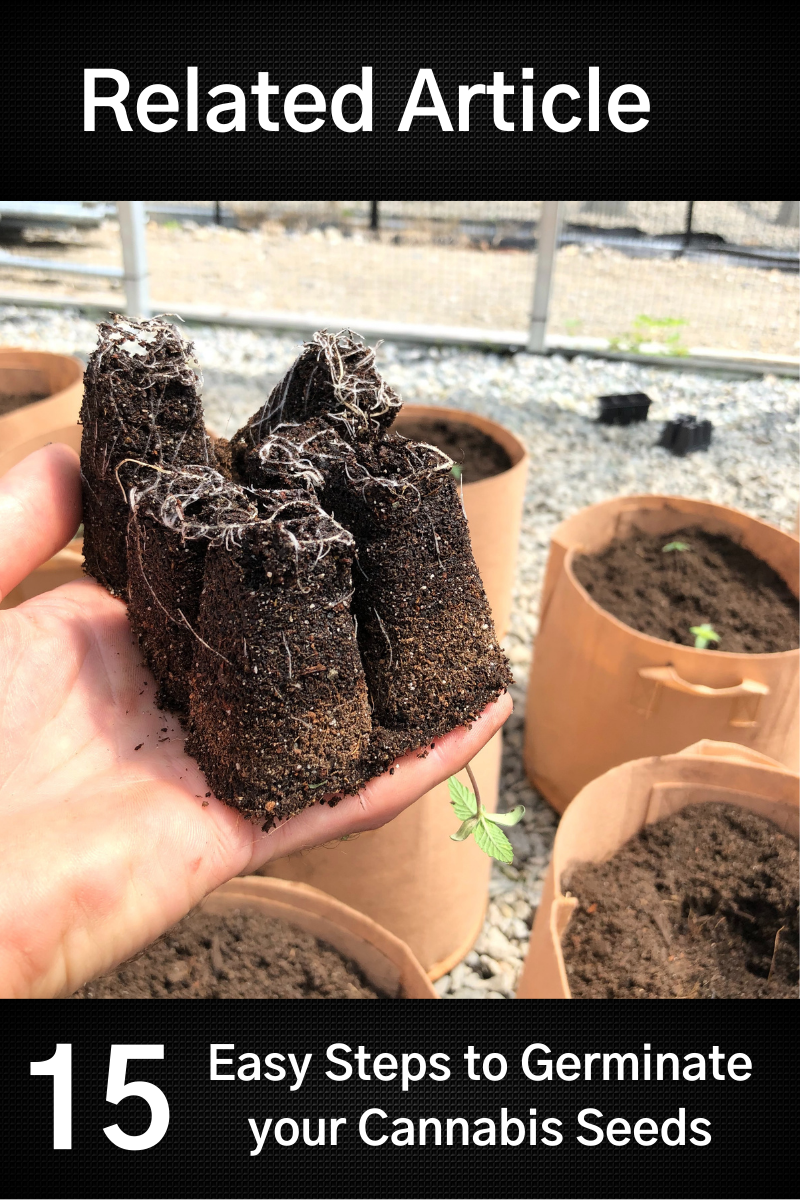
Cannabis seeds are protected by a durable seed glaze.
This seed coat is softened by the presence of water.
In most cases scarification, or roughening of the seed coat, volition assist h2o to penetrate and brainstorm the procedure of germination.
Penetration of h2o and oxygen into the seed begins a metabolic reaction which fuels initial institute growth.
A taproot, or radicle will emerge from the base of the seed and begin growing down into the soil.
This root radicle will orient its growth toward the earth's center through a procedure known equally gravitropism.
As the root becomes anchored in the soil, the shoot volition button upwardly through the soil surface.
The seed coat will commonly stay fastened to the tiptop of the shoot until information technology is pushed off by the growth of the kickoff set of leaves.
The first prepare of leaves to emerge are very simple in form, and known as seed leaves, or cotyledons.
As presently as the cotyledons emerge, they begin to photosynthesize, or catechumen light energy into fuel for further growth. This marks the beginning of the seedling stage.
3) Seedling Stage
Equally presently as the first true leaf ready has emerged, the plant will require sufficient lite to avoid elongation, or stretching for the light.
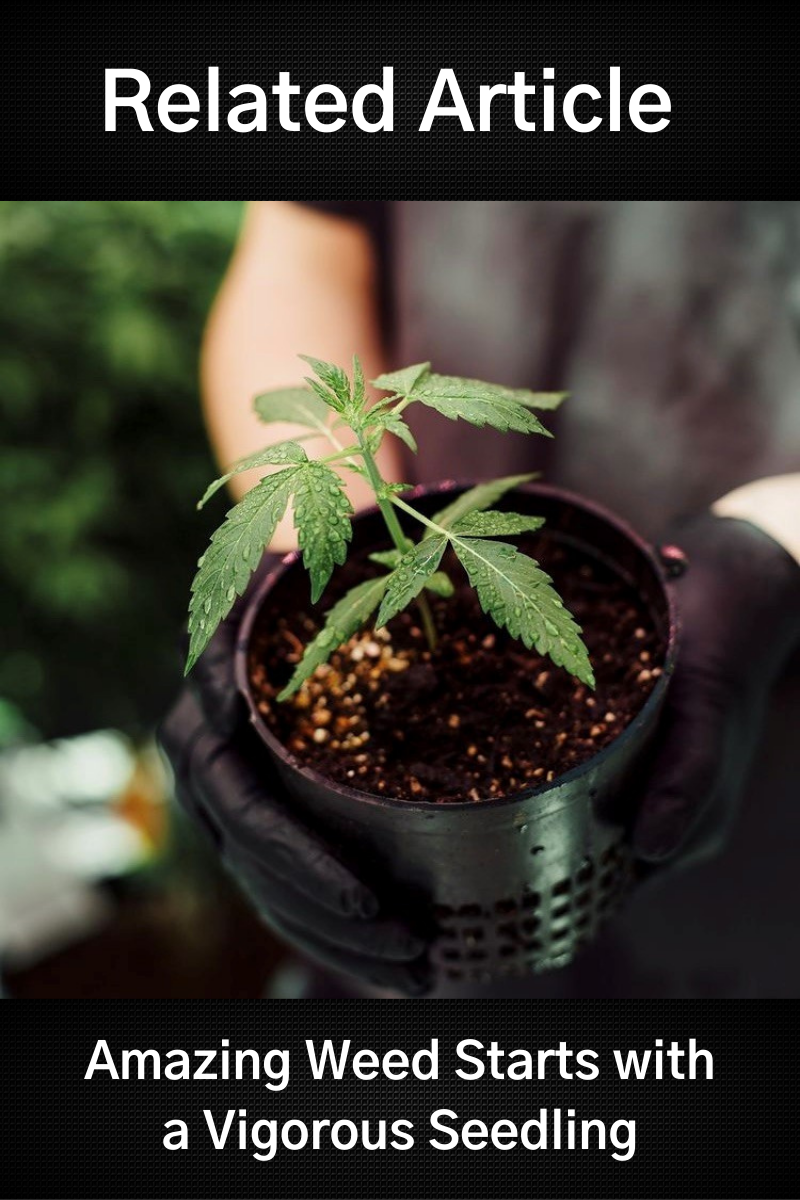
The bulb growth stage ordinarily lasts for 15 to 20 days equally the immature plant becomes more established.
The second set of leaves to emerge are too single-bladed, simply have serrate edges, and wait like cannabis leaves. This is the first true foliage set.
Subsequent leaf sets occur in pairs, on reverse sides of the stem and foliage blades will typically increment to 3, 5, and and so 7 blades as the plant matures.
The intersection of each leafage stem (petiole) with the main stem is known as a node. A new shoot will emerge from each node as the establish matures.
Seedlings are unremarkably either germinated in modest iv" cups or germinated in root plugs before being transplanted into pocket-size cups or pots upwards to 1 gallon in size.
Autoflower seeds are usually germinated in plugs and transplanted directly into their concluding pot. Autos take a very fast lifecycle and are not tolerant of multiple transplants.
four) Vegetative Growth
Once a cannabis found has a well-established root arrangement, and 4-half dozen nodes of growth it enters the vegetative growth stage. The platonic relative humidity at this stage is 65-70%. The found will keep to elongate and develop mature 5 to 7 blade leaf sets.
Seedlings are usually potted up into a 1-gallon pot, or directly into their final pot for the vegetative growth stage. This allows for root expansion to support continued growth of foliage. Every bit cannabis plants mature, secondary shoots at each node of growth volition brainstorm to develop foliage sets of increasing complication.
If weather condition are favorable, your cannabis plants will abound like a weed during the vegetative stage. When plants are well rooted, and growing vigorously, grooming and pruning techniques will help shape the establish for hereafter production without compromising growth.
Several grooming techniques are commonly applied to cannabis plants to increment the number of colas, or height flowers, while decreasing overall elevation of the plant. These techniques include low stress angle, and loftier stress interventions like topping.
v) Sexual Maturity
Nigh Cannabis plants will get developmentally mature when they reach 14"-20" in height, or 8 to 10 nodes of growth. At this stage the leaves and shoots at each node will begin to alternate, rather than occurring opposite each other. Plants may begin to pre-blossom, developing reproductive organs that allow determination of their sexual activity.
Cannabis plants are dioecious, meaning that male and female reproductive organs occur on unlike plants. This is fortunate for u.s., equally it allows us to select the desirable female plants, while eliminating male plants earlier they tin can seed our crop.
Feminized Seed
There are a few reliable ways to ensure that our plants are all female person.
Hi quality feminized, or all female person, seeds are now widely available for purchase. These seeds tin relieve a lot of time and resources for cultivators regardless of size of their garden.
When sourced from a reputable breeder, the plants grown from feminized seed will be over 99% female, with a very small percentage of hermaphrodite or intersex plants.

Genetic testing
At that place are also genetic tests available to determine if a establish is male person or female person.
These toll most 10 dollars per test and tin can very accurately place plant sexual activity through genetic analysis.
For abode growers, facing strict plant counts, information technology is very helpful to rapidly decide the sexual practice of your plants, and exist assured of consummate accuracy.
The process normally involves removing a cotyledon from a seedling, compressing it with blotter paper, and mailing the sample to a lab.
The resulting sample is legal to postal service anywhere in the world, every bit no cannabinoids are present. In most cases, genetic testing costs less than growing plants until they are mature enough for visual identification.
Visual Identification
The traditional way to separate male plants from female is through visual identification during the pre-flower stage. These pre-flowers will form side by side to the stipule at the base of each node.
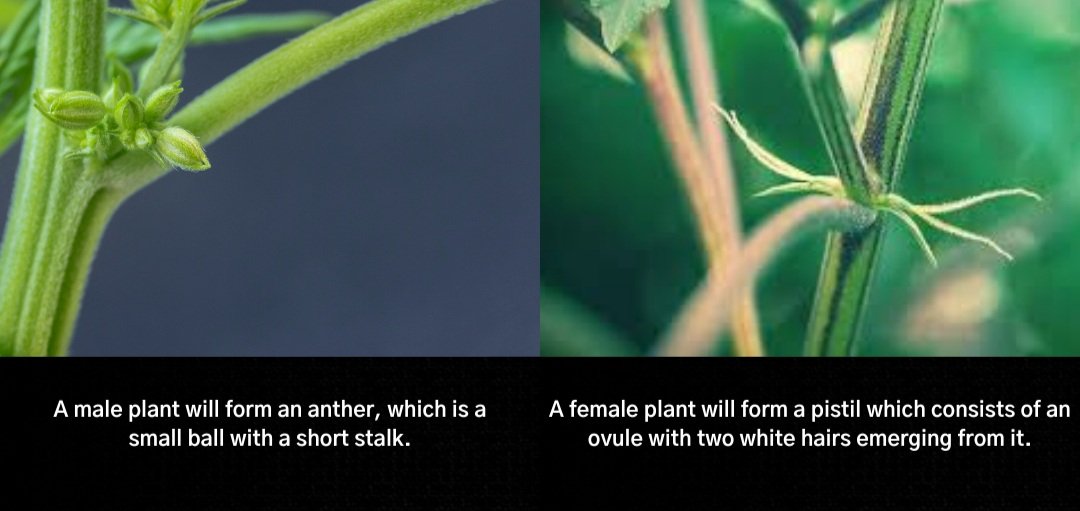
Visual identification is straightforward, but with some strains the pre-flowers may non be evident until subsequently flowering has been induced. This is inconvenient and tin can outcome in gaps in flowering canopies, and adventitious seeding if growers are not attentive.
half-dozen) Early on Bloom (Stretch)
Cannabis plants are either autoflower or photoperiod plants.
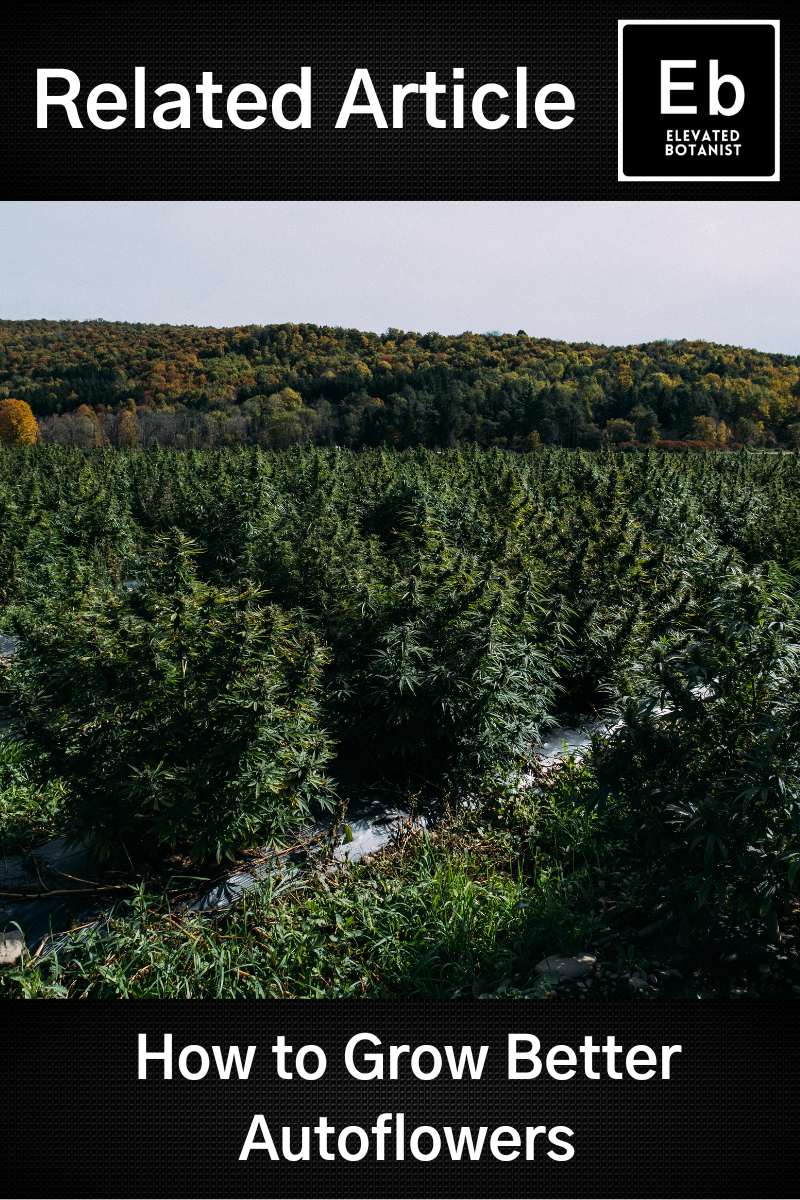
Autoflowering plants will enter the early-flower phase afterward x-20 days of vegetative growth.
Photoperiod plants will brainstorm to flower when they receive more than x-xi hours of uninterrupted darkness during each 24-hr period.
Plants brainstorm to elongate, or stretch nigh 5 days later on inbound flower, and terminate growing taller after about 3 weeks.
The early flowering stage is really a hyper vegetative period.
At this point the plant has been trained and a trellis is usually installed to support the large cannabis flowers that are merely start to form.
Lots of organic Nitrogen, and plentiful water is necessary to sustain vigorous growth.
Platonic climate conditions for this stage of growth include 55%-lxx% relative humidity and temperatures of 72-84 F (22-29C).
For indoor gardens, light intensity is slowly increased to make up for the reduction in light hours to a 12hour photoperiod.
As flowering progresses, the plant will stop vertical growth, and begin to form much simpler leaf sets. The reproductive organs, or pistils, volition multiply, and cluster into small round buds.
There should be a stiff focus on pest management during the early flower period. Reduction in pest populations to an absolute minimum during early flower will help to preserve crop quality during later on flowering stages when pest pressures are higher, and treatments are more than express.
7) Mid Flower Stage
Plants will stop growing vertically and making new leaves about xx days after flowering begins. The plant's development will shift to flower expansion during the mid-flower stage. Bloom expansion will continue until about 35 days after initiation. Relative humidity should exist reduced to l-60% to limit the chance of fungal disease.
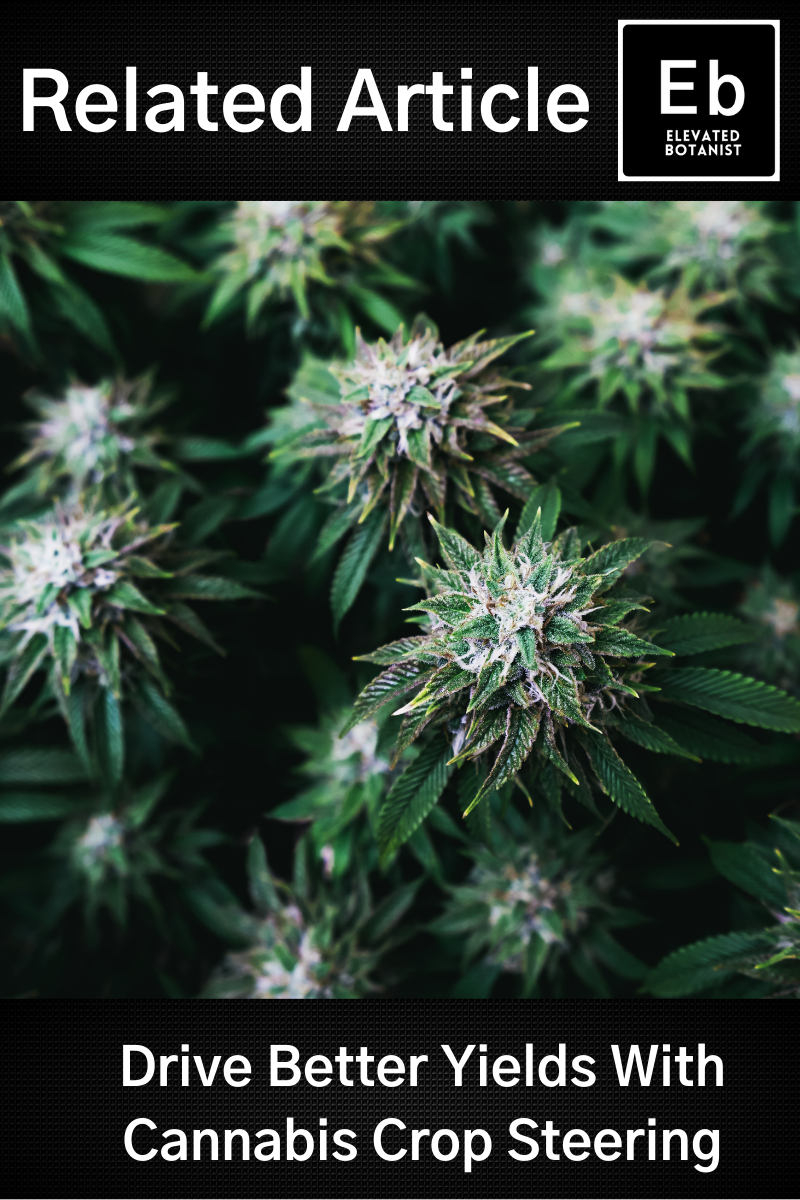
At this stage, plants are at the meridian of their reproductive potential.
Pistils have congregated to form big flower sets, or colas.
Each pistil is a reproductive organ. Their collective sexual frustration, due to lack of pollen fertilization, results in the profuse germination of psychoactive cannabinoids.
These cannabinoids are synthesized within glandular trichomes.
Other substances, including flavonoids, esters, and terpenoids are besides synthesized by the plant during the peak flowering phase.
The presence of some of these compounds, specially monoterpenes, is very evident during this menstruum due to the olfactory property of success that emanates from the ingather.
Equally the flowers expand, some of the older leaves will start to yellow, and fall off. These should be removed as soon as possible. Some of the fungal diseases that affect cannabis are saprophytes and volition infect dying found fabric.
During early and mid flower, it is often helpful to selectively remove fan leaves.
Fan leaves are removed to allow low-cal to penetrate the canopy and directly illuminate flower sites, and to enable air to menstruum through the awning.
Airflow is important for climate equalization, to preclude disease, and promote establish wellness.
8) Late Flower Stage
The late flowering stage is when the bulk of psychoactive cannabinoids are synthesized. Between twenty and 30 per centum of the dried bloom weight is added during the final ripening phase. Humidity should be reduced to 50-60% to prevent bud rot from establishing in the large flowers. Temperatures should be reduced to a maximum of lxxx degrees Fahrenheit (27 C)
Nighttime temperatures are also often reduced during this growth phase. The reduction in temperature during late blossom serves several purposes.
When the humidity has been reduced, lowering the temperature helps the plant to transpire more efficiently due to a reduction in the Vapour Pressure Deficit (VPD).

Lower temperature can also aid to manage the reproductive bicycle of pests, including the three spotted spider mite, which thrives in hot-dry atmospheric condition.
Lower nighttime temperatures tin also increase the purple coloration in cannabis flowers. Cannabis plants, similar many other plants, will produce a regal paint known as anthocyanin when exposed to temperature extremes.
This paint absorbs light energy as oestrus and helps to protect plants against both hot and common cold temperatures.
Cannabis flowers alter advent every bit the white hairs or stigmas emerging from the pistils dry upwardly and lose their power to go pollinated and class seed. This terminal stage of constitute life is besides known as senescence. Many leaves will begin to yellow and die at this stage, and the found is at its almost vulnerable to pest assault.
Harvest Timing
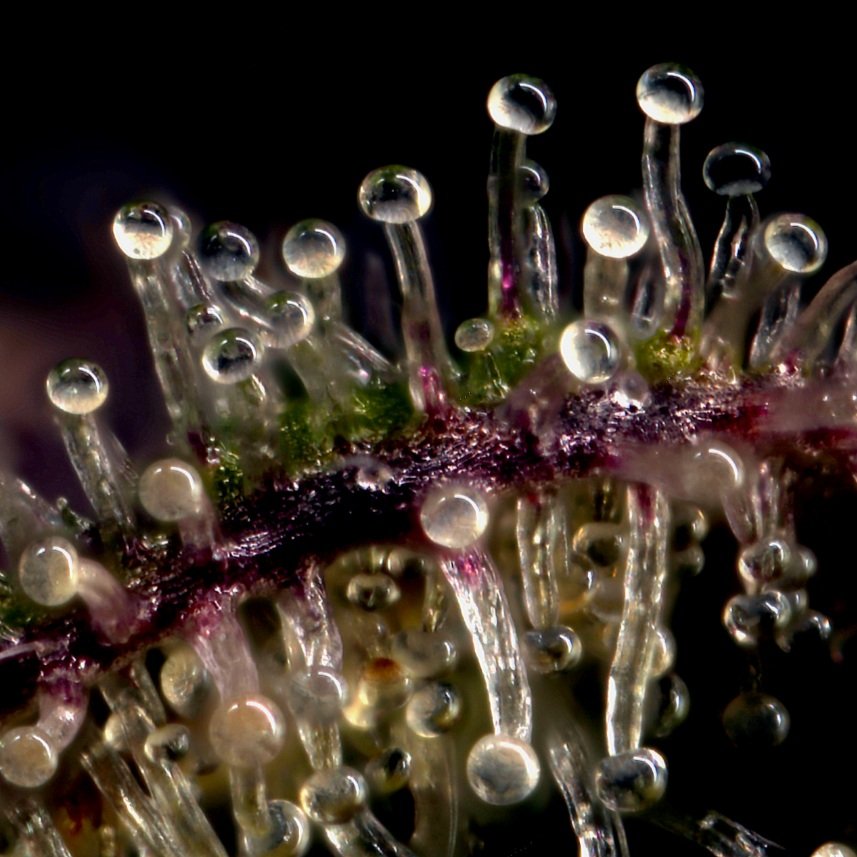
Harvesting Cannabis at the right fourth dimension is an important office of the growing process. Harvesting too early will outcome in loss of yield, and lower THC.
The synthesis of cannabinoids is a continual procedure, and psychoactive THC will dethrone into other non-psychoactive substances like CBN if the flowers are harvested too late.
The most accurate way to decide if a blossom is ready for harvest, is to examine the plants trichomes using a magnification tool. A magnifying drinking glass, jeweler'due south loupe, or smart phone camera can exist used for this purpose.
Trichomes are formed every bit clear structures, and change appearance as cannabinoid synthesis progresses. Trichomes become opaque, or milky colored as they mature, and so amber as they dethrone.
The optimal time to harvest will vary by strain, and by user preference. Most strains will exhibit peak THC content when most of the trichomes are opaque, and a few take turned amber.
Drying and Curing
Great cannabis can exist ruined during the drying and curing process. Fresh cannabis will retain more of the volatile monoterpenes, and other bioactive compounds when properly dried and cured. Cannabis should exist stale slowly, under low temperatures for the all-time effect.
Hang-drying cannabis branches slows the drying process by allowing wet from the stem to migrate into the flower prior to evaporating into the environment. This process usually requires 14 days hanging prior to trimming and packaging.
Growing your ain cannabis is not rocket science, simply your chances of success are much higher if y'all pay attention to your plants needs during the various evolution stages. Electronic mail me if you want to be included in my mailing listing, and I volition update you lot on new cultivation content one time or twice a calendar month.
Source: https://www.elevatedbotanist.com/grow-basics/the-8-growth-stages-of-your-cannabis-plant

0 Response to "How To Count Nodes On A Weed Plant"
Post a Comment